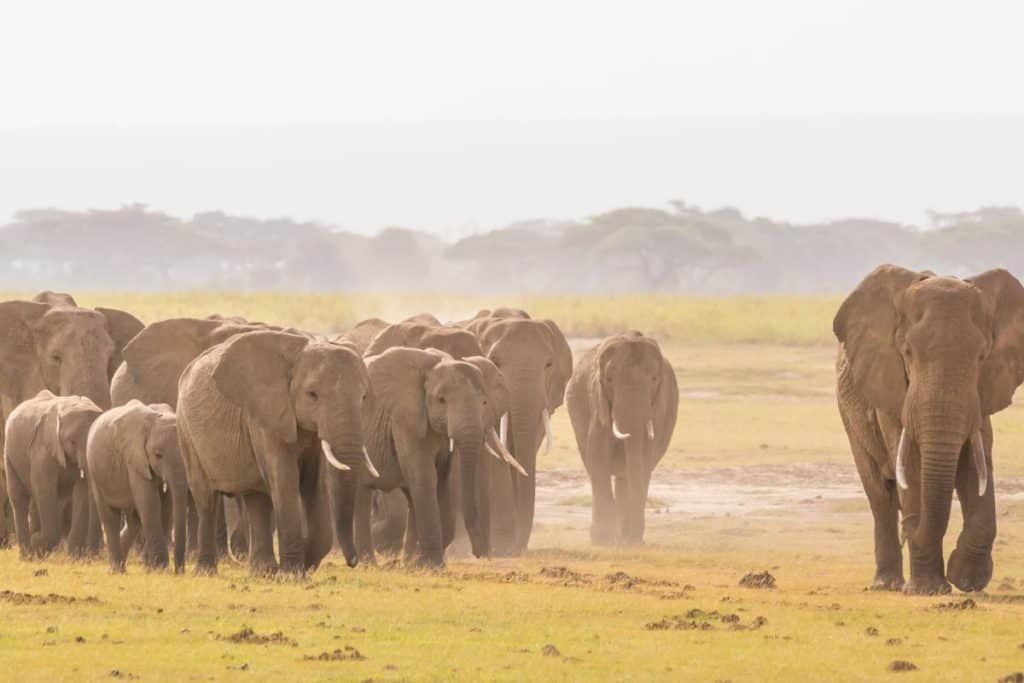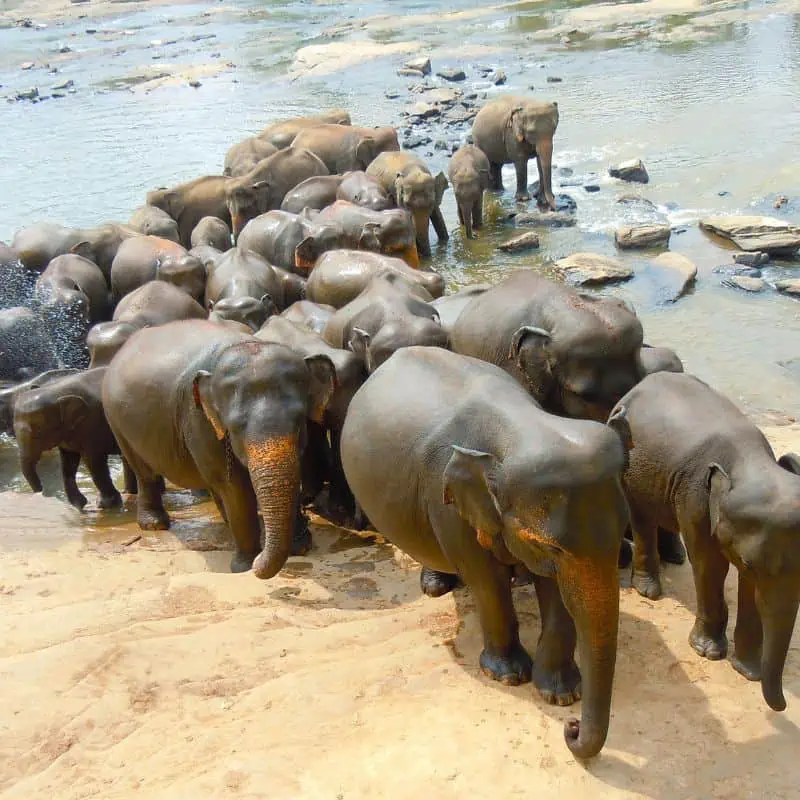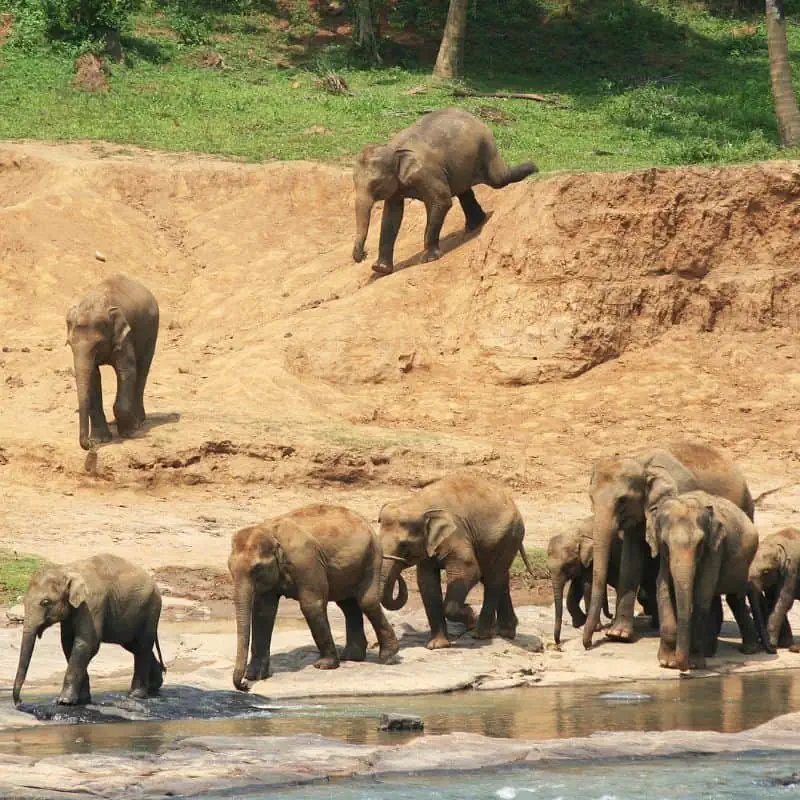Elephants mostly walk, run, or play in structured groups. It’s a wonderful sight, but what is a group of elephants called?
A group of elephants is mainly called a Herd, a parade, or a memory. A group or a herd of elephants has three or more females and baby elephants alongside a matriarch. Male elephants leave their families after a certain age and only rejoin the female group when it’s time for mating.
In this article, we will explore the various terms used to describe a group of elephants, as well as their social structure and behavior.

What Do We Call a Group of Elephants?
An elephant rarely ever lives alone. Most live in a group structured as a small joint family.
Hunters from the Middle Ages named a group of elephants a “Herd.” However, you’ll also hear the work parade or memory used to describe a bunch of elephants.
Let’s learn more about these terminologies.
What’s a Herd?
Herd refers to a group of animals, especially mammals migrating, feeding, and living together at a place. Three, or more than three, animals in a group form a herd.
Elephants are known for their unity and strength as a group. All the members of this small group take care of each other like a family.
They’re highly protective, social, and empathetic to one another. Hence, a group of elephants is popularly called Herd.

What Does Parade Of Elephants Mean?
The term parade means march or walk. You would often see the word parade interchangeably used to describe a group of elephants.
If you ever find an elephant group walking on a path, notice their coordinated movements, slowly moving ears, and dangling trunks – all in perfect coordination.
Besides, given the heavy weight of their body, elephants can’t ever jump; not even their calves can jump.
Hunters from the late middle age referred to a group of elephants as a parade considering their beautiful march or procession.
What’s a Memory Of Elephants?
Elephants are brilliant animals. They have a firm grasp of their memory. Moreover, elephants can remember faces; like dolphins or monkeys, they can even mimic humans.
So, a group of elephants is sometimes called a Memory of elephants.
What Is The Average Size Of An Elephant Herd?
Surprisingly, there’s no specific size of a herd of elephants. It typically ranges from 4 to 100 elephants per group. So far, the largest group of elephants was seen to have 144 elephants.
The size of a herd of elephants depends on the climate, terrain conditions, and availability of food and water resources.
Moreover, it’s rare to find different-sex elephants intermixed in one group. They’re only spotted together when it’s time for breeding or mating.
Furthermore, elephants usually split themselves into smaller groups if the group gets bigger.
Elephants have a unique attachment to their family members. Even after separation, they look after each other and the other group’s members. Pure love and affection.

Structure of an Elephant Group
The social hierarchy of an elephant group is itself incredible. A group of elephants has a matriarchal and multigenerational organization.
A female leader always leads the group (yes, elephants are feminists).
However, only some females get to lead. Only the wisest and oldest female cow, the matriarch, protects and leads the group.
When the oldest female elephant dies, her daughter continues her legacy. However, if the most senior female had no daughter, the second oldest and wisest female elephant becomes the leader.
Not surprisingly, a male elephant (bull) never leads the herd of elephants. That’s because male elephants usually leave their family group at around 14 or 15 years and join an all-male group of elephants.
There, the oldest and the wisest male leads the male group.
Hence, a female group of elephants consists of the matriarch, her daughters, her sisters, and baby elephants.
Male elephants only come back during breeding season or when it’s time for mating.
It’s believed that the oldest elephant in the group usually gets to mate with a female counterpart. And after that, the male bull either lives on its own or joins the male group of elephants.
How Do Elephants Communicate In The Group?
Elephants are socially well-developed mammals. They have powerful senses. Usually, elephants talk with acoustic communication using different sounds. They produce low to high-frequency sounds.
The sounds vary from rumbles to snorts, roars, barks, grunts, or growls. Each sound has a specific meaning signifying excitement, danger, aggression, or simply expressing emotions.
Apart from verbal communication, elephants also have a non-verbal way of communicating with their loved ones. They rub their trunk against each other to show affection (like a giant human hug).
Not only that, but elephants also have visual, chemical, and tactile ways of communication.
Final Thoughts On Elephant Groups
Elephants are playful when around their group. They hunt for food, march, and stay united at all times. So, to sum up, a group of elephants is commonly called a herd, a parade, or a memory. Mostly, herd.
The matriarch or the female leader leads the elephant’s group, like a mother protecting and guiding the young.
So you now know what a group of elephants is called and how they live and socialize.
FAQs
What Is the Offspring of an Elephant Called?
In a zoologist’s language, the female elephant is called a cow. A male elephant is called a bull. And baby elephants are termed calves.
Can Elephants Talk?
Yes! Like any other animal, elephants can talk. As mentioned earlier, elephants have different ways of communicating with each other. They can even socialize with humans. However, they don’t speak our language but produce different sounds to express themselves.
What Group of Animals Do Elephants Belong To?
Elephants are mammals belonging to the family Elephantidae. Mammoths are the closest relatives of elephants. Additionally, elephants are the largest land animals in groups called herds.

